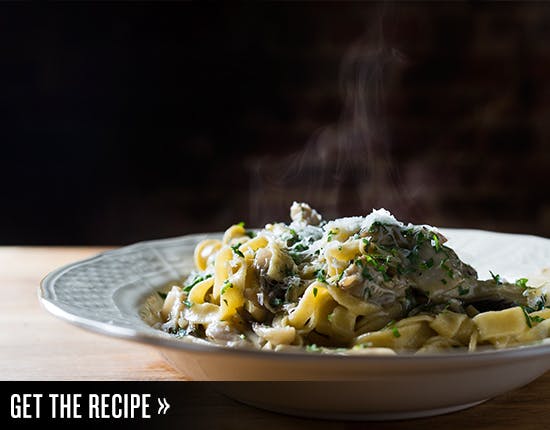A Recipe From "Mastering Pasta" Cookbook By Marc Vetri
Marc Vetri wants you to make more pasta from scratch
We may receive a commission on purchases made from links.
Marc Vetri strolls into our Test Kitchen wielding an imposing three-foot wooden rolling pin.
The chef/owner of six Italian restaurants in Philadelphia soon shows us that by using only his hands and said pin—nothing else—he can make beautiful fresh pasta in a matter of minutes. (Shaping and cooking, of course, require a few more tools.)
It's second nature for the chef, whose new book, Mastering Pasta ($30), aims to take the intimidation out of working with dough. In it, the Italian food scholar and pasta guru—whose restaurants range from the exquisite tasting-menu-only Vetri to its casual cousin, Pizzeria Vetri—breaks down basic techniques and recipes to give readers a better understanding of the noodle. Throughout the book, he's essentially saying: Flour is not the enemy.
"People are scared when they have to use flour for anything. Once you read about it and start to understand it, it's really not that hard," Vetri says.
"This was the book I've wanted to write my whole life," he continues. "When you're at a restaurant, you may have an appetizer and a fish and a meat, but when the pasta comes out, it's just . . . smiles. It's everything. It's flavor. It's texture. It's variation."
Vetri makes it look effortless, almost meditative—"it" being making fresh pasta (see the recipe). The process starts, of course, with flour. Not only is the type of flour you use essential to texture, Vetri says, but also to flavor: "Wheat starts to lose its flavor after 48 hours. Anything you buy at the store is not going to have a lot of flavor."
His advice? Mill your own. "Home milling is going to be huge. Remember when there was only one espresso machine? Now there are countless ones, because there was a coffee craze. Next there's going to be a wheat craze."
Moving calmly and deliberately in our Test Kitchen, he makes a mound of 00 and freshly milled Red Fife flours, brushing out a well for two whole eggs and six yolks, as well as some salt, water and olive oil. Vetri swirls and breaks the yolks with his fingers, mixing the flours and the liquid until they incorporate into a sticky dough. Then comes the kneading—a step not to be taken lightly. Don't tickle the dough, Vetri advises. Really get in there.
"Knead with your whole force," he says. "You want to get the dough to a Play-Doh-like consistency."
Vetri rolls out the dough into one large sheet with that impressive pin, pausing occasionally to test its thickness. He holds the sheet up to the light to check if it's thin enough to see his hand through it; then he folds it into thirds, flouring each layer, so they won't stick together, and cuts it into slim strips, tossing the tagliatelle-size noodles into the air to separate.
The sauce is all about texture and building up flavor: Vetri melds different-size pieces of morels, oyster and trumpet mushrooms with sautéed onions, fortifying the mix with stock and fresh herbs. He cooks the pasta in heavily salted water for mere seconds before transferring it to the sauce, swirling and tossing to thicken the sauce and coat each noodle (get Vetri's tips on saucing pasta here).
The finished pasta is as smooth as a Luther Vandross song, each strand bathed in just enough velvety sauce. Vetri's restraint shows in every bite: You get a mushroom morsel here, a delicate noodle there, some fresh herbs and the bite of Parmesan cheese—but no one ingredient outshines another.
"You have all the layers of flavor," Vetri says. "It's supposed to taste like mushrooms, but you know everything else that's in there. It's harmonious, like a happy marriage."
If he offers to make us more, we'd happily accept his proposal.


